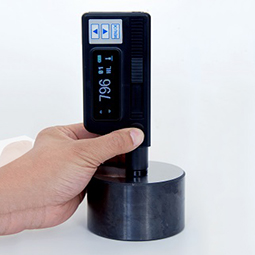Find the Ultrasonic Flaw Detector , Portable Flaw Detector and Digital LeebHardness Tester
Of all the applications of industrial ultrasonic
testing, flaw detection is the oldest and most commonly used technique.
Generally, sound waves of high frequency are reflected from flaws and generate
clear echo patterns.
Portable flaw detector
record and display these echo patterns. Ultrasonic testing is a safe testing
method that is widely used in various service industries and production
process, particularly in applications where welds and structural metals are
used.
Sound waves are mechanical vibrations that pass
through a medium such as liquid, solid or gas. These waves pass through a
medium at a particular velocity in an expected direction. When these waves bump
into a boundary having a different medium, they are transmitted back. This is
the principle behind ultrasonic flaw detection.
Most Ultrasonic
flaw detector use frequencies between 500 KHz and 10
MHz per second. At frequencies in the megahertz range, sound energy travels
easily via most common materials and liquids, but does not pass efficiently via
air or similar gasses. Also, sound waves of different types travel at different
rate of velocities.
Additionally, wavelength refers to the distance
between two subsequent points in the wave cycle as it passes via a medium. It
is related to velocity and frequency. In ultrasonic flaw detector and
ultrasonic thickness gaging, the minimum limit of detection is one-half
wavelength and the minimum measurable thickness is one wavelength, respectively.
Modern Ultrasonic Flaw Detectors such as TFD900 and
TFD800 are small, portable, microprocessor-based instruments suitable for both
shop and field use. They generate and display an ultrasonic waveform that is
interpreted by a trained operator, often with the aid of analysis software, to
locate and categorize flaws in test pieces. They will typically include an
ultrasonic pulser/receiver, hardware and software for signal capture and
analysis, a waveform display, and a data logging module.While some analog-based
flaw detectors are still manufactured, most contemporary instruments use
digital signal processing for improved stability and precision.
TMTECK offers a variety of devices for enhanced flaw
detector inspection. These portable
ultrasonic flaw detectorsare designed for excellent inspection performance and
usability. Our full range of portable
ultrasonic flaw detectors provide outstanding capabilities for locating
subsurface defects.
TMTECK offers digital
Leeb hardness tester that work on direct impression
methods (similar to conventional machines), rebound method (measured in LEEB value)
and UCI method. Measured hardness number can be easily converted into any other
scale like Rockwell, Superficial Rockwell, Brinell or Vickers.
Direct impression method has various probes for
different loads and controlled with the load cell mechanism. These lightweight
testers can be carried to any site with ease. They are equipped with an LCD
operating console, user friendly interface with easy test settings and generate
clear results, real time statistics and graphs.
These testers are operative up to 360° degrees of
positioning, even upside down. In compliance with ASTM E110 and ISO 50157
hardness standards, it can do hardness testing on almost all metals: chromed
surfaces, nitrided surfaces, aluminum, brass, copper, bronze, metal wire,
ceramic items, glass materials, hard/soft steel and hard/soft plastic.



Comments
Post a Comment